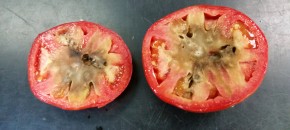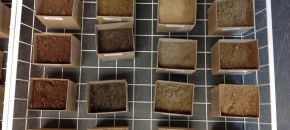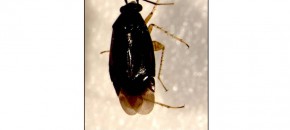Late blight was confirmed in a homeowner garden today near Clementon, NJ (Camden County) and here at the Rutgers research station near Bridgeton, NJ (Cumberland County). This is a good reminder that as long as weather conditions are conducive, the threat of late blight in the state and region will continue until the first killing […]
Continue reading...Internal Fruit Rot in Tomato

A fresh market tomato from a home owner garden was dropped off the other day with some strange internal rot. The internal rot (photo 1) was most likely caused by water accumulating in areas immediately around the stem and as the fruit developed growth cracks (photo 2). This allowed for opportunistic fungi and bacteria into […]
Continue reading...New Jersey Soils and Copper Fungicide Use

During my field visits to Mercer County organic farms, growers often express concerns about negative soil health impacts from copper based fungicides. In an effort to evaluate soil copper use and the resulting soil copper levels, soil was sampled at fifteen farms throughout the state. Both conventional and organic farms participated in this study which was […]
Continue reading...Odds and Ends

Springtime 2014 seemed like it would go on forever. Temperatures remained cool for an extended period and we had plenty of moisture, which are the conditions that always result in shade tree leaf diseases. Here are a few we saw…
Continue reading...Leaf blight in Dill
Leaf blight in Dill as shown up in the past week in some areas of southern New Jersey. Leaflets on plants will appear wilted, often on the lower portion of the plant first. Up close, irregular lesions will appear scattered over the leaflets, girdling them, causing them to look wilted. There have been a couple […]
Continue reading...Bug Damaging Cranberries Identified: Plagiognathus repetitus

This year we observed damage to cranberries likely caused by an unknown “mirid” bug (Hemiptera: Miridae). These insects are known as true bugs and have piercing-sucking mouthparts to suck juices out the plants. The species has now been identified by Dr. Thomas Henry, from USDA-ARS-Systematic Entomology Laboratory in Beltsville, MD, as Plagiognathus repetitus (Hemiptera: Miridae). The insect […]
Continue reading...